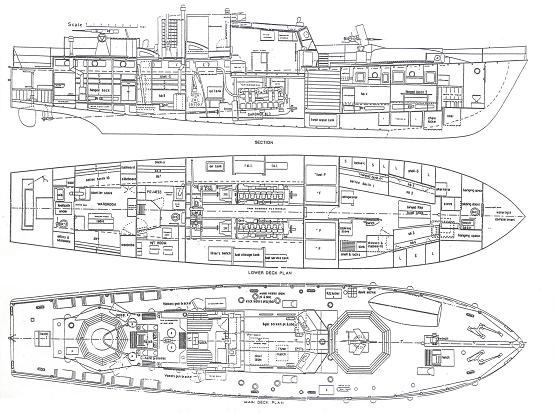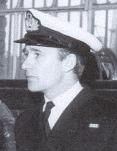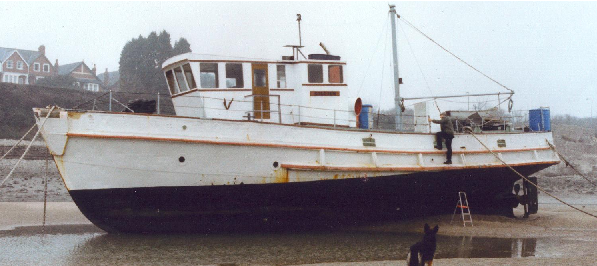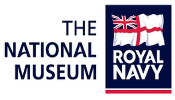
From
"Allied Coastal Forces of World War II. Volume I: Fairmile
Designs and U.S. Submarine Chasers" by John Lambert and Al
Ross, Conway Maritime Press, 1990 - an excellent source
for more details:
"Eight HDML's were required for service
in the West Indies, and to ensure that they could make
the long haul from the Cape Verde Islands to the USA,
they were provided with an outfit of sails. Two
tabernacle masts were fitted (one ahead and one
astern of the bridge). The foremast carried a
standing lug and jib, with the mizzen mast a standing
lug. A large square sail was also provided for running
before the wind. This long passage was never made,
however, as those particular boats joined the forces
engaged in the North African landings after their
arrival at Gibraltar.
..... instead,
Tony Beasley, a motor boat enthusiast, and sometime
commanding officer of T.S. Cossack, the Barry, South Wales
unit of the Sea Cadet Corps (photo below), may
well have made the very first trans-Atlantic crossing in
an HDML - and partly under sail.
HDML.1001 was sold out of RN service in
November 1949, one of her owners being a Mr K Mackie. Tony
then bought the “Peggy Doreen” as she then was, on 29 July
1972 from Belsize Boatyard, St Denys, Southampton, British
Reg. No/Official/Yard No
183304. Powered by two Thornycroft
diesels, he worked on her in Barry for a number
of years, and registered her as the “Welshman” with the Small Ships Registry - the name of a cruiser
minelayer lost in World War 2, perhaps a more
suitable name for an ex-HDML. In May 1990, he sailed her
to Grenada in the West Indies and worked her there for
nearly two years. Then in May 1992, the M/V Welshman was
sold to American couple, Dagny
Sellorin and Edward Teja,
PO Box, Hong Kong, but residing in Grenada. (Her
subsequent career is being summarised)
“Welshman” with the Small Ships Registry - the name of a cruiser
minelayer lost in World War 2, perhaps a more
suitable name for an ex-HDML. In May 1990, he sailed her
to Grenada in the West Indies and worked her there for
nearly two years. Then in May 1992, the M/V Welshman was
sold to American couple, Dagny
Sellorin and Edward Teja,
PO Box, Hong Kong, but residing in Grenada. (Her
subsequent career is being summarised)
Following
are some of the background information Tony collected
about HDML.1001 and photographs of M/V Welshmen. He also
went on to buy and convert a small Admiralty tug. Probably
very little information is available about this type of
vessel and so details of her and three photographs are
included for the record.
You
can email Tony at
anthony.beasley1@ntlworld.com
The
above plans are Thornycroft drawing No.23927 dated
5/4/43 supplied
by
National Maritime Museum, Greenwich.
Please click for enlargement.
|
|
1.
NAVAL HISTORICAL BRANCH INFORMATION on the CAREER of
HDML.1001
NAVAL HISTORICAL
BRANCH
MINISTRY OF
DEFENCE
Empress State
Building London SW61TR
12. April 1983
Mr A M Beasley,
Barry,
South Glamorgan
Dear Mr Beasley,
Thank you for your
letter of 10 March 1983 regarding ML 1001.
Through the number
of the vessel I have been able to trace a skeleton of
her history but I am afraid that is virtually all it is
- bones and no meat.
Despite the number
I am not altogether sure that ML 1001 may be described
as being the first of the type since the first to enter
service were, as far as I can trace, MLs
1029 and 1030 in October 1940. It is more probable that
she was the first ordered; another of the-type, ML 1002,
was also built by Lady Bee Ltd.
ML 1001 first
appears in our records in April 1941 when, along with MLs
1008, 1010, 1020, 1036 and 1067, she is mentioned as
being due on completion to join ML 1024 to form the
105th ML Flotilla under Nore
Command (Sheerness). MLs
1010 and 1021 joined in May 1941 and ML 1001 in June.
The Flotilla was finally complete by September 1941 (ML
1070 replacing ML 1067). Throughout her service with the
Flotilla ML 1001 remained based at Sheerness apart from
brief periods for repairs and refits. However, of this
group of vessels, MLs 1010,
1021, 1036 and 1070 went to the Clyde on detached
service in November 1942; in June 1943 MLs
1008 and 1020 went on detached service at Machrihanish;
and in November 1943, ML 1024 went to Lowestoft as a
training vessel.
In February 1944
ML 1001 was allocated for special hydrographic duties,
operating under the survey ship HMS
FRANKLIN. She was taken in hand for alterations
and additions at Dorset Yacht Co Ltd, Poole, joining HMS
FRANKLIN at Rosyth in
March. I have been unable to trace any further movements
after this until late October 1944 when she was
undertaking a survey of the Seine Estuary with
instructions to proceed to Ostend on its completion. If
she went to Ostend she did not linger long, for December
saw her back at Sheerness for a refit.
By February 1945
she had returned to the Continent at Le Havre, leaving
there on 5 May for Cuxhaven to assist in a survey of the
Elbe and Hook prior to Operation Dropkick in which
Cuxhaven and Hamburg were swept for mines. In late June
her presence is recorded at Wilhelmshaven but by early
August had returned to London for a refit, her special
survey duties apparently completed as she was back with
the Nore Command in
February 1946.
After this details
become even patchier but a further refit was undertaken
in March 1946 and the summer of '46 would appear to have
been spent in the Humber area. In November she was at
Sheerness and, in the main, spent the remainder of her
service in 'Care and Maintenance' variously at Sheerness
and Chatham, until November 1949 when she was sold.
Once again I am
sorry I have been unable to discover anything of greater
substance.
Yours sincerely
M McAloon
2.
FURTHER INFORMATION on HDML.1001
From
Brian Holmes, February 2005
Builder
Lady Bee,
Southwick Sussex 2/6/41
Wartime
Activities
1944 - Fitted
with echo sounders and allocated to Hydrographic
Survey duties, Crew replaced by a specialist surveying
party.
6/44 -
Operation Neptune - Invasion
of Normandy [see D.1 - below]
Surveying the
site for the British Mulberry Harbour at Arromanches
9/44 - Entered
Cherbourg, which was still mined, for a four week
survey of the port.
Surveyed the
River Seine up to Tancarville
Post War Fate
1945 - Survey
Motor Launch, SML.I
1949 - For
Disposal
2000 -
Floatstreet, based
in Trinidad
Known Crew
Temp Lt D C
Waylen RNVR, commanding officer, 11/1/41-12/43
Temp
Lt Richard Thurston Bailey RNVR, commanding
officer, 6/44-c5/45
*Lt
Cdr C S E Lansdown
RN, attached as a specialist survey officer 1944
Lt R K Husband
RN, commanding officer, 5/45-7/45, also as Assistant
Surveyor 2nd class
Decorations
Mention in
Despatches (MID) - Temp Lt
Richard Thurston Bailey RNVR, for services at Arromanches
during the Normandy Landings
*Lt Cdr C S E Lansdown
RN, specialist survey officer - his career
1926-28 - HMS
Endeavour in the Red Sea and off Malta
1928 - HMS
Flinders off the south and west coasts of England
1929 - HMS
Rosemary in home waters
1930 - HMS
Fitzroy off the east coast of England
1931 - HMS
Flinders off the west coast of Scotland
1931-33 - HMS
Herald off Malaya, Borneo, Hong Kong and in the South
China Sea
1934 - HMS Kellett
off the south and east coasts of England
1935 - Course in
controlled minelaying
1936-38 - HMS
Stork off Thailand and Ceylon
1939 - HMS
Gleaner off the south coast of England and the west
coast of Scotland. Involved in
the attempted rescue operations for HMS/M Thetis.
1939-43 - HMS Astraeas,
a Blue Funnel liner taken up for controlled
minelaying. He was awarded an OBE in 1943 for service
in her.
1944 - ML 1001
for survey work in support of Operation Neptune before
commanding HMS Astral for which he was awarded a DSC
(see following note). This was a former Belgian pilot
vessel employed in surveying recaptured ports.
1945 - Joined
the Hydrographic Department.
Note: Further
research suggests Lt Cdr Lansdown was awarded his
DSC for setting up HMS Royal Anne (Naval Party 1500)
on the 6th June 1944 at Arromanches and that the
vessel he commanded was HDML.1001, not the
ex-Belgian vessel. A report on the duties of survey
ship HMS Scott at this time (www.halcyon-class.co.uk)
confirms that Lansdown was working from a surveying
motor launch - "8.6.44
- By D+2 Lieutenant Glen had positioned and sunk the
first of a dozen or so blockships which were to form
the eastern breakwater; and Lieutenant Commander
Lansdown had arrived in his surveying motor launch
to begin the survey of the port, which was
developing daily on the plan that had been based
upon the reconnaissance survey. Teams from SCOTT,
using our surveying boats, augmented Lansdown's
sounding work."
3.
BACKGROUND to the HDML's
From Web Site: seawar.bom.ru
It may seem an
ironic fortune, but English boat companies during the
interim period between the First and the Second World
Wars were hunting for their customers around the world -
in England herself they were not dignified by the
Admiralty's attention. The Royal Navy, which despised
boats for long time, was caught by surprise by the
outbreak of the war with Germany. It turned that the
organized defence of the estuaries, harbours, and naval
bases practically did not exist. It was not until
towards the end of 1939, after three months of war, that
the Admiralty urgently formulated tactical and technical
requirements for the harbour defence motor launch - the
HDML.
The HDML's
were 72ft-long and their displacement had to enable
their transportation by cargo ships. Their seaworthy,
round bilge hulls were made of wood, and were fitted
with two rudders to improve their agility while fighting
enemy submarines. Three English companies supplied
engines, which ranged from 130 to 160 hp,
The bridge was protected by light armour. Originally it
was planned to arm those boats with one fore 45mm gun,
one aft 20mm Oerlikon, two
machine-guns, and eight depth charges, but in fact their
armament varied. The orders for HDML's
were placed with numerous yacht manufacturers, which
might introduce changes into construction along the
service specifications. Thus the bottoms of the boats
designated for the Mediterranean were coated with copper
for protection of barnacles, The
boats designated for Iceland were fitted with the system
of forced heating and ventilation, and had improved
thermal insulation. During the war it occurred, that
transporting boats by ships is practically impossible,
and that the boats must be prepared for long autonomous
sailing. The hull construction was quite fit: the boats
sailed to the Mediterranean and Iceland on
their own. There were also sails and rigging
provided for several boats designated for West Indies,
but then it turned that they were needed in Africa
rather and a transatlantic trip under sails was
cancelled.
The HDML boats by
their characteristics were close to the submarine
chasers of Fairmile B type,
and they were used as patrolling boats, submarine
chasers, auxiliary trawlers, navigation vessels, and
landing crafts, During the
war the English built over 1700 boats of various types.
The lion share belonged to the Fairmile
B - 650 boats. Next to them were the HDML's
- 450 boats, followed by various motor torpedo and gun
boats - 300 units of each, English shipbuilders were
particularly proud of the pace the patrol boats were
developed and built; they considered it a significant
technical achievement. The 1947 edition of the Jane's
Fighting Ships emphasizes, that HDML boats gained a good
reputation. [Jane's 1946/47] Those were extremely
pleasant and easy to handle crafts, extremely seaworthy,
with reliable engines. And possibilities of their
practical use surpassed everything the designers could
envisage.
4.
An HDML ESCORT AROUND the TIME of NORMANDY
From Web Site:
combinedops.com
We returned to
Ostend and received orders from "on high" to proceed
back to the UK in a violent storm with force-8 winds
blowing. We formed a small convoy escorted by a Harbour
Defence Motor Launch (HDML). Being flat-bottomed
we took a severe beating from the rough and angry sea as
we smashed down from the top of one wave into the trough
before the next wave. I was standing at the port rail
near our bridge, casually looking down the side and I
noticed a weld opening and closing under the stress. I
notified our skipper who came down from the bridge to
see it for himself. He
signalled the HDML to say he was leaving the convoy and
we went into Newhaven to wait out the storm. After
assessing the damage, we gradually crawled, port to
port, along the south coast to Portsmouth where the big
shots evaluated our damage and decided we were ready to
be scrapped. We received instructions to make our way
back through the Channel as the weather allowed. We had
seen more than one LCT broken in half at the main weld
between the tank space and the stern section. With the
stern section actually towing the bow section, it
presented a very strange image!
|

